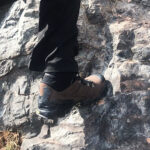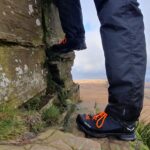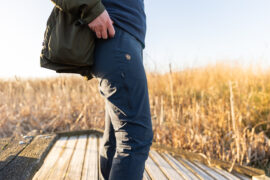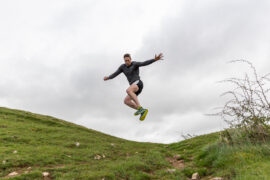Follow Rachael from our Exeter Shop as she takes on La Sportiva’s solid lightweight walking boot and gives her thoughts.
…
I was fortunate enough to be able to review the La Sportiva TX5 GTX Boots, which are a mid-cut approach boot. After wearing them for several months I have used them on a variety of terrain including coastal paths, gravel routes through the moors, off-roading on the moors, and clambering up and down boulders. These boots have been fantastic for my needs and have not let me down. If you keep reading, you’ll find out why these boots are so good!

Every part of the TX5 has been thought through to give the wearer the best experience possible. The protective cuff derived from the La Sportiva Trango family ensures a snug fit around the ankle and lower leg. Admittedly, it did take a little getting used to; the first few times I wore the boots out I needed to loosen off the upper laces as I felt there was too much pressure on my lower leg muscles. After a few times of use, this pressure eased off as the back of the boot softened slightly and I was able to tighten the laces the way they are intended to. In the long term the back might soften up even more to the point where I don’t feel like I’m getting support from the boots but after a few months of having the boots, I have yet to experience this.
As I had to adjust the lacing to ensure a more comfortable fit, I didn’t need to worry about this causing my foot to slide around thanks to the differentiated lacing system. This lacing system allows the wearer to have different levels of tightness over the lower foot compared to the upper half. Even if I have to loosen off the bottom of the lacing, I can get a tight fit around the ankle and leg allowing me to make sure my heel doesn’t lift when walking, or my feet to slide forward when moving downhill. Furthermore, depending on the thickness of sock I wear, will influence how tightly I lace the bottom half. Another well-thought-out design is the top two open eyelets; these are fairly closed which limits the chances of your laces catching in the opposite boot eyelets.
The Nubuck leather uppers are soft and mould around the upper foot. During warmer weather, I had to wear lightweight walking socks as the leather component made my feet heat up. They are, however, not as warm as a full leather boot thanks to the synthetic tongue, but are not as breathable as a full synthetic option. The tongue leads up to a high gusset which prevents dirt and mud from getting easily into the top of the boot as well. The upper part of this tongue does not appear to be lined with the Gore-Tex membrane but so far when it’s been wet enough to potentially cause an issue I’ve been wearing waterproof over-trousers which protect this part of the boot. The run-off from my over-trousers in intense rain onto the lower section of the boot has not been a problem even when I see the upper material wetting out. No moisture makes its way into the boot itself, so my feet remain dry and the upper material dries relatively quickly (within a few hours if I keep moving, or overnight if I remove the boots). Protecting the joining between the upper and the sole is the abrasion-resistant rand which should help to increase the time it takes for creases to develop where the foot naturally bends. The rand raises at the front to a slightly higher toe cap allowing me to feel more at ease when walking on Dartmoor and on coastal paths as I know I will undoubtedly be kicking some rocks along the way, but the leather will be well-protected.

A Vibram MegaGrip compound outsole gives me peace of mind when I am scrambling around rocks as it is very grippy, and with the differentiated lug pattern it means I have good traction. When moving downhill, or on softer terrain like mud, the depth of the lugs allow for sound purchase. The underfoot stabiliser make the TX5 suitable for extended use, or if the wearer is carrying a heavy load. Whilst not the stiffest boot you can buy, the stabiliser gives it good rigidity which over a longer period of time reduces the chances of someone experiencing foot fatigue as the muscles in your feet are having to work less. The Impact Brake System provides additional shock absorption on varying terrains, even whilst carrying a heavier pack. It would not be advised to wear this boot on concrete, pavement or tarmac for prolonged periods of time, as you will wear through the sole at a faster rate due to the rubber not being designed for this type of terrain.

Aftercare and cleaning:
Now, I want to extend the lifetime of my boots as much as I can. To do this, I need to make sure that I keep them as clean and dry as possible. If I allow the boots to become dirty, this can stop the waterproof membrane from working efficiently as well as the water-repellent coating on the outside of the boot.
Step one is to clean the boot. A very basic method is to wipe the boot with a damp cloth, or rinse the boot under a small amount of water to get the worst of the dirt off. If you can’t remove the dirt straight away then you can always brush this off when it has dried, and then give a rinse at a later date. Removing soils from the sole of the boot is advised, especially in Devon as the soils are very acidic down here, as this can affect the compounds in the sole if not removed. To ensure the cleanest possible result, use a technical cleaner – either Nikwax Footwear Cleaning Gel, or Grangers Footwear and Gear Cleaner. These technical cleaners will be most effective at removing dirt whilst not hindering the Gore-Tex waterproof membrane. Remove the laces when you are cleaning the boot to enable you to get any dirt stuck in the gusset of the tongue, as this is often an overlooked area of cleaning.

When the boot is as clean as possible, it is important to reproof it, to add a layer of water repellence that has either worn off over time, or been removed in the cleaning process. The reproofing stage is best done when the boot is still damp, but not dripping. As the TX5 has dual fabrics used in the upper construction, there are different methods to reproof the boot. One would be to use a product that is suitable for dual fabrics, such as Nikwax Fabric and Leather Proofer, Grangers Footwear Repel Plus, or Meindls Conditioner and Proofer.
The method I am choosing to use on my boot is a little different; I am going to be using a proofer suitable for the synthetic tongue (e.g. Grangers Footwear Repel Plus) and a wax for the nubuck leather. Nubuck leather is a brushed leather, so when wax is applied, it changes the appearance to more of that like a full grain leather boot. This process is irreversible once the wax has been applied so the appearance will never return to its original state. Using a soft wax, like Grangers Waterproofing Wax, means it is easy to rub in to the nubuck leather with minimal effort. Meindl Sport Wax is another soft wax option, or if you would prefer something that requires a little more work to administer but should take longer to wear off, then the Grangers G-Wax is a suitable alternative. These waxes are all beeswax based so they do not damage the synthetic stitching whilst still nourishing the leather. Once I’ve rubbed the wax in with a cloth in a few thin coats, I then take a buffing brush to the boot to even out the wax I’ve applied and make it look a little shinier. Leave the boots to finish drying out in a cool, well ventilated space;

I expect to get a lot of mileage out of these boots although I am aware I will need to look after them to ensure they stay in the best shape possible.
Overall, I think the TX5 has been a good boot to wear for most of the use I have put it through. It is relatively light, was fairly comfy straight out of the box and has good performance in the wet conditions we experience in the UK for many months of the year.
…
Available in both men and women’s variants…









